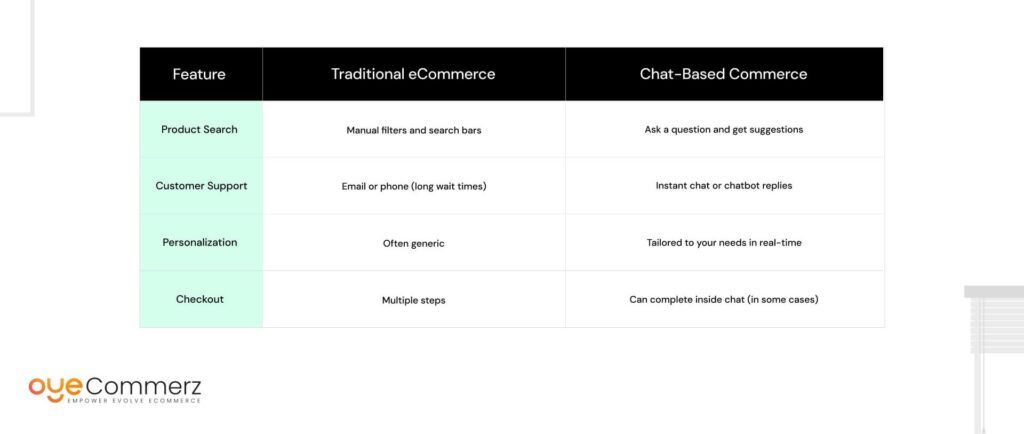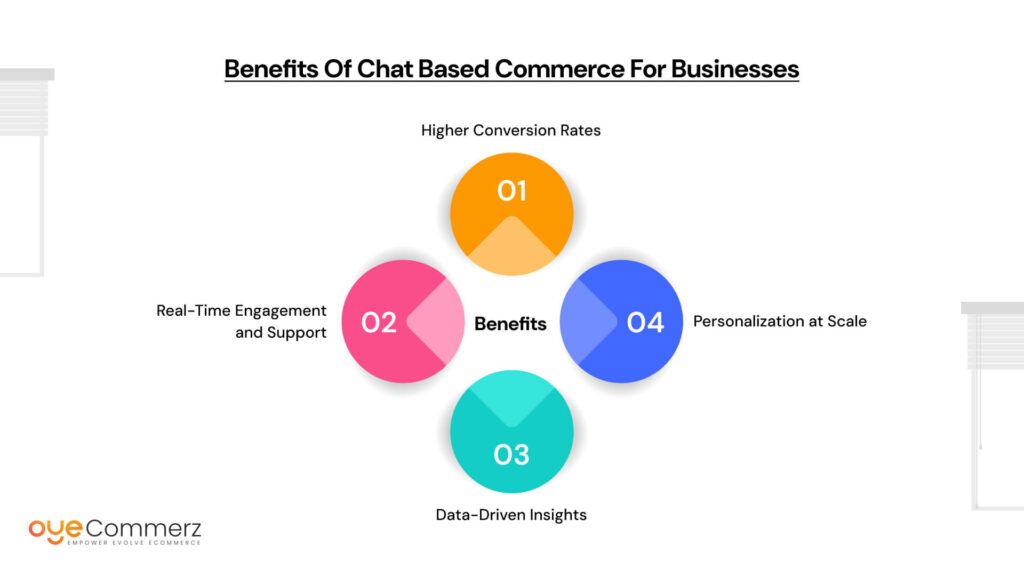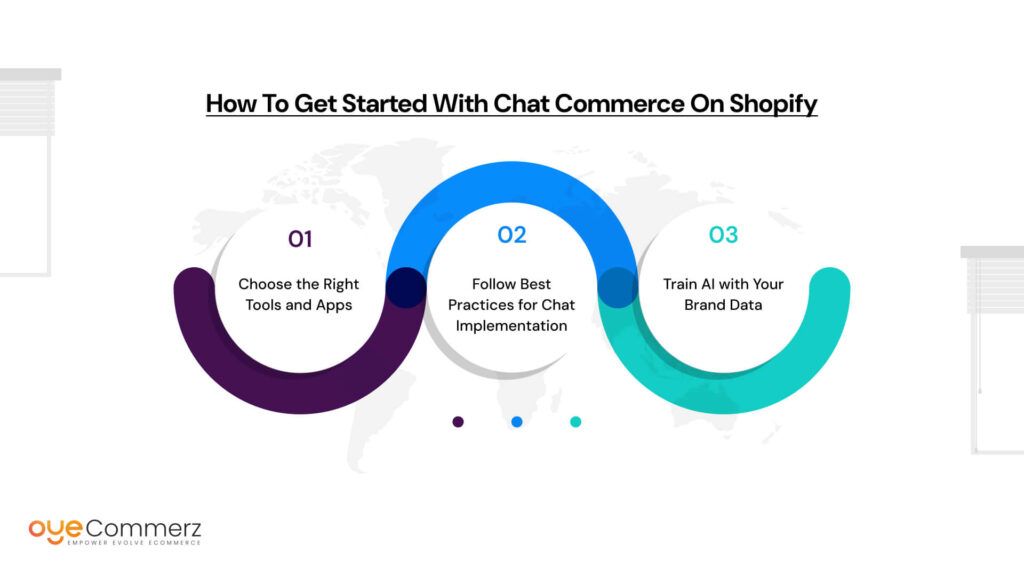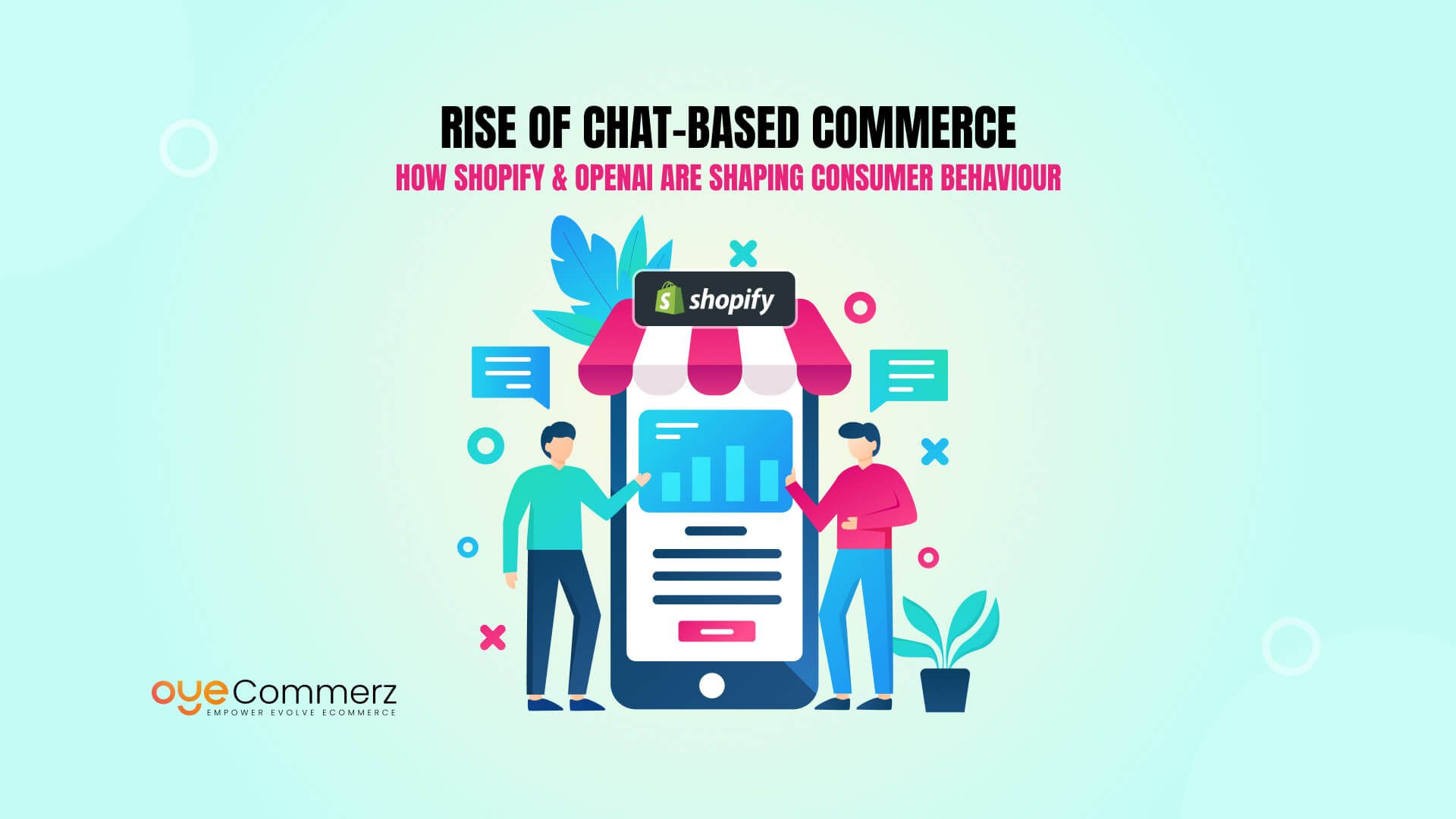Have you ever chatted with a website assistant that helped you find the right product or answered your questions instantly? That’s called chat-based commerce and it’s quickly becoming the new way people shop online.
Today, shoppers want quick answers, personal help, and smooth experiences. Thanks to smart tools like ChatGPT by OpenAI and powerful platforms like Shopify, businesses can now talk to customers in real-time and help them shop without any confusion or delay.
In this blog, we’ll look at how these new technologies are changing the way people buy things online. You’ll see how chatting with a store (instead of just clicking around) is making shopping faster, easier, and more enjoyable for everyone.
Table of Contents
ToggleWhat is Chat-Based Commerce?
Chat-based commerce is a way of shopping where customers can talk to businesses through chat tools just like texting a friend. Instead of clicking through menus and product pages, people ask questions, get suggestions, and even place orders by chatting.
How it works:
It uses tools like:
- Live chat on websites
- In-app messaging (like chat windows in shopping apps)
- AI chatbots that can answer common questions or recommend products
- Voice assistants like Siri or Alexa
- Messaging apps like WhatsApp, Facebook Messenger, and Instagram DMs
These tools allow businesses to help customers in real-time anytime, anywhere.
Real-life examples:
- A skincare store on Instagram helps you pick the right product through DMs.
- A chatbot on a Shopify store helps you track your order.
- You ask a smart assistant for “running shoes under $100” and it shows you options.
Why it’s growing fast:
According to a 2024 report:
- Over 67% of online shoppers have used chat during their shopping journey.
- Chatbot use in eCommerce is expected to grow by 25% year-over-year.
- WhatsApp commerce is booming, especially in countries like India, Brazil, and Indonesia.
This growth shows that people love quick, helpful conversations when they shop especially when they don’t have time to search on their own.
The Consumer Shift: From Clicks to Conversations
Online shopping used to mean clicking through lots of pages, menus, product lists, filters, and checkout steps. But now, more people are moving toward a faster, easier way to shop: chatting.
What’s changing?
Shoppers no longer want to spend time searching. They want quick answers, personal suggestions, and help when they need it. That’s why they’re turning to conversational interfaces like chatbots, live chat, and messaging apps.
Why do people prefer chat?
- Instant answers: No need to wait or search. Just ask and get help right away.
- Personalized help: Chatbots and AI assistants can recommend products based on what you like or need.
- Less effort: You don’t have to scroll through long pages. A quick conversation can do the job.
Traditional vs. Chat-Based Shopping

As shopping becomes more mobile and fast-paced, chat offers a smoother, more natural way to shop like talking to a store assistant, but online.
The Role of Shopify in Chat Commerce
Shopify is one of the most popular platforms for building online stores. But it’s not just about websites and checkouts anymore Shopify is now helping businesses connect with customers through chat.
Shopify’s Ecosystem: Built for Conversations
Shopify gives store owners all the tools they need to sell online but it also helps them talk to customers in real time using built-in and third-party chat features.
Chat Integrations Shopify Supports:
- Shopify Inbox – A free tool that lets merchants chat with visitors on their store in real time. It also connects with Facebook Messenger and Instagram.
- WhatsApp Chat Apps – Merchants can install WhatsApp widgets to talk to customers directly from product pages.
- Live Chat and AI Chatbots – Shopify supports many chatbot apps (like Tidio, Gorgias, or Re:amaze) that can automate replies, recommend products, and handle customer questions.
How Shopify Merchants Use Chat to Grow Sales
- A clothing store uses Shopify Inbox to help visitors choose sizes and styles, which reduces returns and increases sales.
- A local bakery uses WhatsApp chat on their site to take same-day orders and send delivery updates.
- A tech accessories brand uses a ChatGPT-powered bot to guide users through choosing the right charger or cable.
By using chat, these stores make the shopping experience feel personal, helpful, and fast and that’s exactly what today’s customers want.
How OpenAI is Powering Smarter Commerce
Artificial Intelligence (AI) is making online shopping smarter and OpenAI is leading the way with tools like ChatGPT. This technology helps online stores understand customer needs better, respond faster, and offer more personalized experiences.
What can AI do for eCommerce?
AI can:
- Personalize product suggestions based on what a shopper likes or needs.
- Answer questions automatically (like a smart store assistant).
- Understand natural language, so shoppers can search using their own words—not just keywords.
Real Use Cases:
- Conversational product recommendations: A customer says, “I need a gift for my dad who loves cooking,” and the AI shows a list of top-rated kitchen gadgets.
- Natural language search: Instead of typing “running shoes men black,” a shopper types, “Show me comfy running shoes for men under $100” and the AI understands and delivers.
- Automated support: ChatGPT can answer questions like “Where’s my order?” or “What’s your return policy?” instantly, without needing a human agent.
Real-World Examples:
- Online fashion stores use AI chatbots powered by OpenAI to help customers pick the right size or style.
- Home decor brands use conversational AI to guide shoppers through room themes or color palettes.
- Electronics stores use it to explain technical specs in simple terms, like “What’s the difference between this laptop and that one?”
By using OpenAI tools, businesses can save time, reduce customer support load, and create a shopping experience that feels more human even though it’s powered by machines.
Shopify + OpenAI: A Game-Changing Combination
When you combine Shopify’s powerful eCommerce platform with OpenAI’s smart technology, the result is a shopping experience that’s faster, friendlier, and more personalized than ever before.
Shopify handles the store, the products, and the checkout. OpenAI adds the intelligence of understanding what customers want, how they speak, and how to guide them to the right purchase.
How it transforms the shopping experience:
Let’s say a customer visits a Shopify store selling skincare products.
- Instead of searching through categories, they type:
“I have dry skin and I’m looking for a gentle face wash.” - A ChatGPT-powered assistant replies with 2-3 product suggestions based on skin type, reviews, and current stock.
- The assistant explains why each product is a good fit, shows real reviews, and even checks if there’s a discount.
- The customer adds a product to cart and completes the purchase all within the chat window.
No clicking around. No guessing. Just simple, helpful conversation.
Benefits for store owners:
- Lower support costs: AI handles most of the common questions automatically.
- Better engagement: Shoppers stay longer and feel more connected when they get real-time help.
- Higher sales: Personalized suggestions lead to more purchases and more upselling (like “buy the set” or “add a matching serum”).
This powerful combo of Shopify + OpenAI is changing the way people shop and making it easier for store owners to grow.
Benefits of Chat Based Commerce for Businesses

Chat-based commerce isn’t just helpful for shoppers it’s also a big win for businesses. By talking directly with customers through chat, brands can sell more, support better, and learn faster.
1. Higher Conversion Rates
When shoppers get quick answers and personal help, they’re more likely to buy. Chatbots and live chat reduce confusion, help with decision-making, and guide customers through checkout all of which leads to more sales.
Studies show that websites with live chat can see a 10–20% boost in conversion rates.
2. Real-Time Engagement and Support
Instead of waiting for an email or sitting on hold, customers can get help instantly. Whether it’s a question about shipping or which product to choose, chat gives them immediate answers which builds trust and keeps them from leaving the site.
3. Data-Driven Insights
Every chat is a goldmine of customer feedback. Businesses can learn:
- What products people ask about most
- Common questions or concerns
- Trends in customer needs or shopping habits
This data helps stores improve their products, content, and customer service over time.
4. Personalization at Scale
Chat-based systems, especially AI-powered ones can personalize the shopping experience for every customer. Whether someone is new or a returning buyer, the chat assistant can remember preferences, suggest relevant products, and even follow up.
And the best part? This can all happen automatically, even if you have hundreds or thousands of customers.
Challenges and Considerations
While chat-based commerce offers many benefits, it also comes with challenges that businesses need to handle carefully to ensure a positive and trustworthy experience for customers.
1. Privacy Concerns and Data Ethics
Customers share personal details during chats—preferences, addresses, order history, and more. Businesses must be transparent about how they collect, store, and use this data.
To build trust, it’s important to:
- Use secure platforms.
- Clearly explain privacy policies.
- Only collect the data you need.
- Follow data protection laws like GDPR or CCPA.
2. Balancing Automation with the Human Touch
AI can answer many questions, but sometimes, a customer just wants to talk to a real person especially for issues like returns, complaints, or custom orders.
A smart approach is to:
- Use AI for common, easy tasks.
- Offer human support for complex or sensitive issues.
- Let customers switch to a human agent at any time.
3. Handling Complex Questions Accurately
AI chatbots are improving, but they’re not perfect. If the chatbot doesn’t fully understand the question or gives wrong product info, it can lead to frustration or lost sales.
To avoid this:
- Regularly train your AI tools with updated product info.
- Test for accuracy and make adjustments often.
- Make it easy for customers to correct the AI or ask for more help.
The Future Outlook: What’s Next in Conversational Commerce?
Chat-based commerce is still growing and the future looks exciting with new technologies shaping how we shop.
What’s coming next?
- AI Voice Shopping: Imagine talking to your smart speaker or phone to buy things. Soon, more stores will let you shop just by speaking, making it even easier to buy on the go or hands-free.
- Multilingual Chatbots: As businesses sell globally, chatbots will speak many languages, helping customers from all over the world in their own language making shopping smoother and more welcoming.
- Hyper-Personalized AI Concierges: In the future, AI assistants will know you better than ever. They’ll remember your style, preferences, and past purchases to give truly personal recommendations like a personal shopper who knows exactly what you want.
The Power of Multimodal AI
The next wave of AI won’t just understand text it will combine text, voice, and images. For example, you might show a photo of a dress you like, and the AI will find similar items for sale. Or you could speak your request and get product images and info instantly.
Shopify and OpenAI: Continuing to Evolve
Shopify and OpenAI will keep working together to make these new features possible. From smarter chatbots to voice assistants and image recognition, their combined technology will keep making online shopping more natural and enjoyable.
How to Get Started with Chat Commerce on Shopify

Ready to bring chat-based commerce to your Shopify store? Here’s how you can get started easily.
1. Choose the Right Tools and Apps
Shopify offers many chat tools that fit different needs:
- Shopify Inbox: Free and built-in, great for chatting with customers live and managing messages from Facebook Messenger and Instagram.
- Tidio: A popular live chat and chatbot app that helps automate answers and recommend products.
- ManyChat: Perfect for creating automated flows on Messenger and Instagram.
- GPT-powered plugins: Some apps use OpenAI’s technology to provide smart, natural conversations with customers.
Pick tools that match your store’s size and customer needs.
2. Follow Best Practices for Chat Implementation
- Keep it simple: Don’t overwhelm visitors with constant pop-ups or too many chat options.
- Make chat easy to find: Place chat buttons where visitors can quickly spot them, like the bottom corner of your site.
- Set expectations: Let customers know if a response is automated or if a human will help soon.
- Offer opt-out: Always give users the choice to close or ignore the chat if they want.
3. Train AI with Your Brand Data
For the best results, customize your AI:
- Feed it product details, FAQs, return policies, and brand tone.
- Regularly update information so the chatbot stays accurate.
- Use customer conversations to identify new questions and improve responses.
This helps your AI assistant feel more helpful and trustworthy.
Ready to Upgrade Your Store?
If you’re excited about bringing chat-based commerce and AI-powered shopping to your Shopify store, we can help! At Oyecommerz, we specialize in seamless Shopify chat integrations and smart AI setups that boost sales and improve customer experience.
Don’t miss out on the future of online shopping. Contact us today for a free consultation or demo. Let’s create a shopping experience your customers will love!
Contact to Migrate your Site to Shopify Now
Conclusion
Chat-based commerce is changing the way people shop online. Customers now prefer quick, helpful conversations over endless clicking. This shift is reshaping how businesses connect with shoppers.
Thanks to powerful platforms like Shopify and smart AI from OpenAI, online stores can offer personalized, real-time support that feels natural and easy. This combination helps businesses increase sales, improve customer satisfaction, and save time.
To stay ahead in the world of online retail, embracing chat commerce is becoming essential. By using the right tools and focusing on customer needs, brands can create shopping experiences that are not just efficient but truly enjoyable.
Frequently Asked Questions
Chat commerce is when customers buy products or get support by chatting with a store through messaging apps, live chat, or AI chatbots.
Yes, chatbots are widely used in e-commerce to answer questions, recommend products, and help customers complete purchases quickly.
Yes, chatting has become an important part of e-commerce, offering shoppers real-time help and personalized shopping experiences.
An example is a chatbot on a store’s website helping a customer find the right product, answering questions, and assisting with checkout all through a chat conversation.




